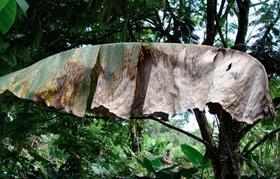
An international consortium, led by scientists from the Wageningen University & Research Centre, claims to have unravelled the DNA of pseudocercospora fijiensis, the fungus that causes the black Sigatoka disease in bananas.
Gert Kema, a professor in tropical phytopathology at Wageningen University, said the findings provide leads for increasing the sustainability of banana production.
“Thanks to the sequencing of the DNA of the pseudocercospora fungus, we are now gaining a greater insight into the interaction between the fungus and the banana plant,” Kema said. “This will help to make banana cultivation better for the environment, the local population and the economy. For example, the insights offer us opportunities to develop a banana plant that is suitable for production and export, and which is also resistant against black Sigatoka.”
Kema said the findings will also provide new information for the development of more effective and, hopefully, more environmentally friendly crop protection products.
Fungicides are commonly used to manage black Sigatoka. The effectiveness of these products often reduces over time, meaning most commercial plantations have to spray increasingly often – over 50 times a year is common practice in many banana producing regions. Wageningen University said this has a major impact on the environment of the plantations and costs the banana sector some US$400m a year.



